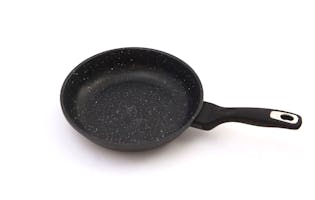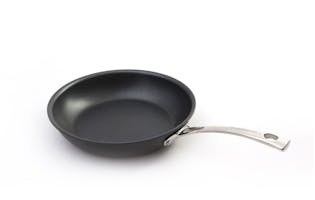Frying pans
Which frying pans cook well and last the longest? Which are easiest to use and clean?
What to look for when buying a frying pan, plus how to look after them.
-

Best budget frying pan
-

Best lightweight frying pans
-

Best pan for use in the oven

Get access to Consumer & see all reviews
✔ Personal support through our Consumer Rights Advice Line
✔ Premium articles and in-depth buying advice
✔ Add a Consumer magazine for even more exclusive content
Which type of frying pan is best?
Good frying pans are usually heavier and more expensive than others because they’re thicker. Thicker pans are less likely to warp when heated, so last longer. They distribute heat and cook more evenly than thin pans, too.
Aluminium frying pans
Non-stick coated pans allow you to cook with less oil and are usually easier to clean. But they shouldn’t be used at high temperatures. While some non-stick coated pans have a stainless steel body, most are aluminium.
Standard aluminium pans are the thinnest and lightest, and the most prone to warping and uneven cooking. Warping can also mean their useful life is short.
Hard anodised aluminium pans are thicker and more resistant to warping than standard anodised or non-anodised pans.
Forged aluminium pans are thicker, so they cook better and last longer than standard aluminium pans.
Cast aluminium pans are another step up. They’re thick and strong and won’t lose their shape. They distribute heat well and cook evenly.
Stainless steel and cast iron frying pans
These pans usually don’t have a non-stick coating (some stainless steel pans do). Instead, oil is used to condition the pan and to reduce food sticking when cooking. They can be harder to clean but have a more durable cooking surface than pans with non-stick coatings.
Those without a non-stick coating can typically be used at high temperatures and some are oven safe.
Stainless steel pans are usually thicker and heavier than aluminium pans. Stainless steel is very durable and non-corrosive. Often it’s combined with aluminium in multiple layers to improve a pan’s heat conduction.
Cast iron pans are thick and durable, but they’re very heavy. They provide an even cooking heat but take longer to get up to temperature and cool down. They can corrode if not maintained but will often last many decades when cared for correctly. See ‘Tips for looking after your frying pan’.
Features to consider
Surface durability: Cast iron and stainless steel surfaces are extremely durable, while non-stick coated surfaces vary. Our test shows which pans are the most durable.
Induction-suitable base: If you want to use your pan on an induction cooktop, choose one with a base stated to be induction suitable. It’ll be magnetic – made of ferrous metal. All the frying pans in our test are suitable for induction cooktops, but there are models that aren’t.
Size: The size given by frying pan manufacturers (eg, 24cm) usually refers to the diameter of the top of the pan. But it’s the base diameter that’s important – you need to make sure it’s the same as the diameter of the element it’ll be used on. That way, your pan will heat evenly and efficiently, it’ll remain stable if on an elevated hob, and the handle won’t overheat. We accurately measure the base diameter of all frying pans in our test.
Handle safety and comfort: Look for a heat-resistant handle such as one made from Bakelite or phenolic plastic, or one with rubber or silicone grips. Stainless steel and cast iron can get dangerously hot. We don’t think they’re safe for children who help with the cooking.
PFOA-free claims: Ignore PFOA-free claims. PFOA (perfluoro-octanoic acid) was previously used in the process of making non-stick cookware coatings (it wasn’t in the coating itself).
It’s been found to build up in the environment and in the human body and has been linked to several adverse health conditions. But, for that reason, it’s no longer used to produce non-stick cookware.
All new frypans are PFOA-free. But it’s worth noting that manufacturers may use similar chemicals from the same family of substances. The impacts of those on human health are not yet fully known.
Tips for looking after your frying pan
Before using your pan for the first time, wash it in warm, soapy water.
Season cast iron pans before using, even if they come ‘pre-seasoned’. This involves heating, oiling and leaving to cool. Then repeat. It’ll create a durable non-stick surface and prevent rusting. Apply a thin layer of oil to your pan after each use, too.
Avoid non-stick cooking sprays on pans with non-stick linings, to prevent damage.
Don’t overheat a non-stick pan. Use only as directed by the manufacturer.
Only add salt to water in your pan when it’s boiling or very hot, to prevent pitting of your pan’s cooking surface.
Use heat-resistant nylon, silicone or wooden utensils rather than metal ones. It’ll reduce scratching and damage to any non-stick coating.
Never soak or rinse a hot pan in cold water. It can warp the base and damage any non-stick coating.
Don’t leave cast iron pans to soak as it can cause rusting.
Hand-wash your pan in warm, soapy water, even if it’s claimed to be dishwasher-safe. Dishwasher detergents can damage non-stick surfaces.
Don’t scrub with a metal scourer – instead, use a soft plastic scrubber or sponge.
Check non-stick surfaces for damage. Replace any pans where the non-stick coating is flaking, peeling or has deep gouges.
When storing a non-stick pan, protect its surface with paper towels before placing anything else against it or stacking other cookware inside it. Ideally, store them separately.
We've tested 17 frying pans.
Find the right one for you.
.jpg&w=315&q=75)

